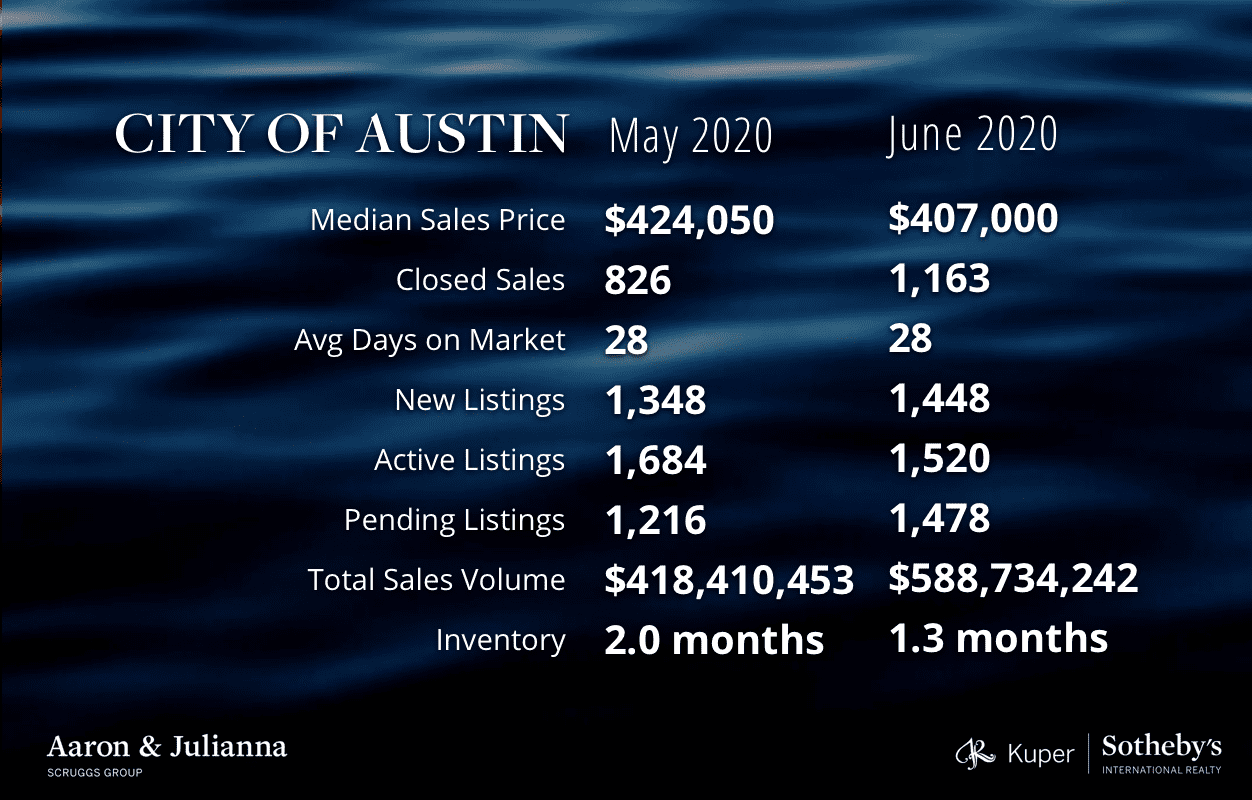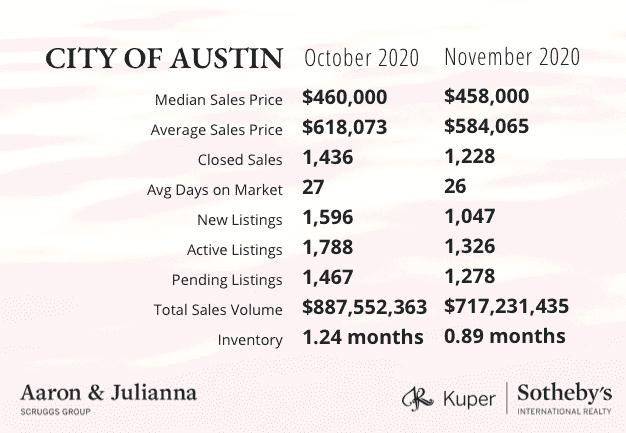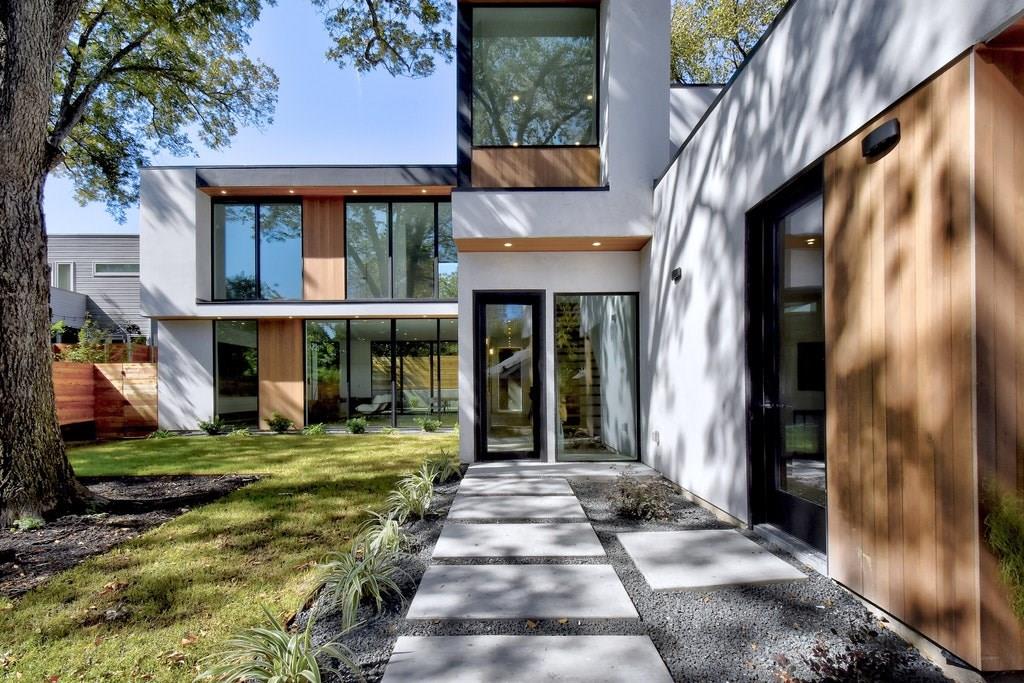Prior to the COVID-19 shelter in place order, Austin’s housing market was on track to push twelve straight years of growth. Typical real estate cycles experience seven to ten years of growth followed by one to two years of recession. We had an extreme seller’s market, with home prices up 13% YoY and less than two months’ supply of housing inventory. But the world has changed drastically in the last month, so where are we now and where are we heading?
Research indicates that Travis County is likely less vulnerable to the effects of the pandemic than other areas. The survey measured the vulnerability of 483 housing markets and ranked Travis County at number 457. While we don’t know the future, we can tell you about the primary statistical indicators of home values and how Austin is doing today. We’ll summarize this data to help inform your opinions about what you’re optimistic or cautious about.
Existing Home Sales
Increasing home sales would normally be a positive indicator. Decreasing pending home sales is a negative indicator.
Austin experienced 2,740 home sales that closed in March 2019 and 2,939 closed home sales in March of 2020 — an increase of 6.77% YoY. Given the rapid changes brought on by this crisis, we should also consider pending home sales. Pending sales have not yet closed but are scheduled to do so, typically within 30-60 days.
There were 3,378 pending home sales in March of 2019 and 2,949 in March of 2020. The 12.7% YoY decrease in pending home sales for March 2020 means that supply is aligning more closely with demand in Austin. We don’t have an overabundance of housing inventory right now because in February of 2020, our housing supply was vastly failing to meet demand. Austin was in the most extreme seller’s market it had ever seen prior to all this. To sum it up, the number of housing sales that closed continued to grow in March, but it is fair to anticipate a slowdown in the coming weeks based on March’s pending sales numbers. Read on to learn what’s driving this slowdown.
Personal Income
Decreasing personal income is a negative indicator.
Increasing unemployment is one factor that could slow the housing market. Since October 2019, Austin has held our lowest unemployment rate on record, of 3.4%. we don’t have specific numbers on how the unemployment rate has changed yet. The fronts of 6th Street bars are boarded up with murals of masked people. I don’t need a statistic to tell me that unemployment is up. Still, it would be nice to know how much higher unemployment is. On April 17th, the state of Texas will issue new unemployment numbers. In the interim, we know that Gov. Greg Abbot issued an essential services order that supersedes local orders. For Austin, this order could keep more people employed. City officials think Austin’s unemployment rate is rising more slowly than other cities. Nevertheless it is rising, and we will know more about how much in the coming week.
The immediate impact of the stock market and Austin’s quarantine is a decrease in market activity. There are fewer people shopping for homes. Market activity now is about half of what we had prior to the Austin’s quarantine and the stock market drop, which occurred roughly around the same time. Decreased market activity could drive a slowdown in the housing market. Nevertheless, many people need to make housing changes right now due to changes in work and family life. The immediate drop in house showings is being addressed through the adoption of new technologies. We are still meeting with buyers and sellers, showing vacant homes, and conducting limited business. We’re just using the internet now to hold remote appointments, virtual showings, and 3D Matterport walkthroughs.
Delinquency Rate
Increasing delinquency rate could be a negative indicator.
This statistic could be the “wild card” for the current crisis. It’s too soon to know what the new mortgage delinquency rate will be. Had no action been taken by banks and governing entities, a significant decrease in employment would greatly increase the delinquency rate. However, all levels of government are taking widespread action to suppress occurrences of mortgage default. We have an Instagram TV video that provides an overview of these programs and dives deep into forbearance options. We also have videos that provide detailed information about Federal financial assistance programs, local programs, who qualifies, and how to pursue them. The programs are far reaching and will help suppress the expected increase in delinquency rate. We’ll learn more about how effective they are in the coming weeks.
Mortgage Rates
Low mortgage rates are a positive indicator.
Mortgage rates are nearing an all time low. Here are a few APRs for 30-year fixed rate mortgages: Wells Fargo, 3.111%; Bank of America, 3.516%; Quicken Loans, 3.49%; Chase, 3.178%. The marketplace average for 30-year fixed rate mortgages is 3.86% APR. And for more expensive homes, 30-year fixed jumbo rates are averaging 3.86% APR. Mortgage rates vary based on a person’s credit, but we can see that mortgage rates are very low. 30-year fixed refinance rates hit an average 3.84% on April 9th, down 0.06% from a month ago. These low rates will certainly help offset the negative impact of unemployment.
Housing Prices
Steady housing prices are a positive indicator.
Home values remain steady in Austin. Rapid change in the lives of individual homeowners could shore up some opportunities. When they do pop-up, we see those homes move very quickly. Banks prefer to give loans to people with income. So if your family has income and you’ve been waiting for a lucky break in real estate, now is a good time to set up search with us.
Homeownership Rate
Steady homeownership rate is a positive indicator.
As people get back to work and adjust to new methods of showing homes during the quarantine, we expect 70%-80% of the market to become reengaged. So, while market activity dropped to about 50% of pre-quarantine engagement, those numbers could return to 85-90% of what they were. In this case, we expect the Austin housing market to rally in Q3 and Q4 of this year.
The last piece of the puzzle for homeownership will lie in forbearance. There are many forbearance options for those with mortgages which we’ll discuss in our Instagram TV video. While the internet is being trolled by tales of lenders trying to get you pay back your deferred payments in 90 days, that’s not the most common scenario. Most forbearance plans defer payments to the end of your loan. Nevertheless, we always encourage getting this information in writing.
Summary
Just as we didn’t predict this pandemic, it’s impossible to know exactly what the future may hold. However, in a survey of 483 housing markets, Travis County was recently ranked in the top 30 least vulnerable.
While existing home sales have not decreased, we do see a decrease in pending homes. Austin was blessed to have one of the strongest housing markets in the United States prior to the quarantine and stock market dip. Since then, local housing inventory is more in line with demand but it is not surpassing demand. Housing inventory is generally not sitting on the market, it is selling. Unemployment will affect our housing market. Austin is doing better on unemployment than most other cities. We’ll know more when new unemployment stats come out on April 17th. The banking industry is working hard to administer federal, state, and local aid for mortgage delinquency. Mortgage rates remain very low, and housing prices and homeownership rates have remained steady through the quarantine thus far.
The bottom line – Austin’s biggest concerns are staying healthy, employed, and sane. Our local housing market is currently holding steady. There are both positive and negative market indicators to consider when looking forward. Our speciality is working with people to create solutions for their individual housing needs and desires. If you need advice on anything that has to do with your home, from solving problems with your housing situation to creating a space more conducive to work and family, please reach out. We’re here to help.



































